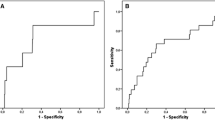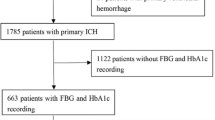Abstract
Stress-induced hyperglycemia (SIH) is a neuroendocrine response to acute illness. Although SIH has an adverse association with intracerebral hemorrhage (ICH), quantitative measures and determinants of SIH are not well delineated. In the present study, we objectively evaluated SIH using glycemic gap (GG) and identified its radiological and clinical determinants, with a 5-year retrospective review of charts of ICH patients. We calculated GG using the regression equation (GG = AG −28.7 × HbA1c + 46.7) and evaluated whether GG is an independent predictor of mortality using a multivariate regression model. Radiological volumes of different intracranial compartments were determined using image segmentation software. We correlated GG with different clinical and radiological parameters using Pearson correlation coefficient (PCC), Spearman’s rank correlation (SRC), and Wilcoxon rank sum test. Then, we calculated the value of GG associated with mortality. Out of 328 patients, 238 (73%) survived hospitalization and 90 (27%) expired. GG was found to be an independent predictor of mortality (r=0.008, p=0.04). Additionally, GG was positively correlated with intraparenchymal hemorrhage (IPH) volume (PCC=0.185, p<0.01) and intraventricular hemorrhage (IVH) volume (PCC=0.233, p<0.01) and negatively correlated with cerebrospinal fluid (CSF) volume (PCC=−0.151, p<0.01) and brain tissue volume (PCC=-0.099, p=0.08). GG was positively correlated with patients’ ICH score (SRC=0.377, p<0.01), Glasgow Coma Scale (GCS) (PCC=−0.356, p<0.01), hydrocephalus (p<0.01), and IVH in the third ventricle (p<0.01). The univariate logistic regression model identified 30.0 mg/dl as the value of GG (AUC=0.655, p<0.01) that predicted mortality with 52.2% sensitivity and 75.2% specificity and defined SIH. In conclusion, GG independently predicts mortality in ICH patients and positively correlates with IPH and IVH volumes. However, causality between the two is not established and would require specifically designed studies.





Similar content being viewed by others
Availability of Data and Material
All data are available on request.
Code Availability
R 4.0.3
Abbreviations
- AG:
-
Admission glucose
- AIS:
-
Acute ischemic stroke
- AUC:
-
Area under the curve
- CT:
-
Computed tomography
- CSF:
-
Cerebrospinal fluid
- CVT:
-
Cerebral venous thrombosis
- EMR:
-
Electronic medical record
- EVD:
-
External ventricular drain
- ICH:
-
Intracerebral hemorrhage
- IPH:
-
Intraparenchymal hemorrhage
- IRB:
-
Institutional Review Board
- IVH:
-
Intraventricular hemorrhage
- mRS:
-
Modified Rankin Scale
- MoCA:
-
Montreal Cognitive Assessment
- PCC:
-
Pearson correlation coefficient
- SRC:
-
Spearman rank sum
- SIH:
-
Stress-induced hyperglycemia
- aSAH:
-
Aneurysmal subarachnoid hemorrhage
- VPS:
-
Ventriculoperitoneal shunt
References
Hemphill JC 3rd, Greenberg SM, Anderson CS, et al. Guidelines for the management of spontaneous intracerebral hemorrhage: a guideline for healthcare professionals from the American Heart Association/American Stroke Association. Stroke. 2015;46(7):2032–60.
Hemphill JC 3rd, Bonovich DC, Besmertis L, Manley GT, Johnston SC. The ICH score: a simple, reliable grading scale for intracerebral hemorrhage. Stroke. 2001;32(4):891–7.
Rau CS, Wu SC, Chen YC, et al. Stress-induced hyperglycemia, but not diabetic hyperglycemia, is associated with higher mortality in patients with isolated moderate and severe traumatic brain injury: analysis of a propensity score-matched population. Int J Environ Res Public Health. 2017;14(11):1340.
Dungan KM, Braithwaite SS, Preiser JC. Stress hyperglycaemia. Lancet. 2009;373(9677):1798–807.
Rau CS, Wu SC, Chen YC, et al. Higher mortality in trauma patients is associated with stress-induced hyperglycemia, but not diabetic hyperglycemia: a cross-sectional analysis based on a propensity-score matching approach. Int J Environ Res Public Health. 2017;14(10):1161.
Rodriguez-Calero MA, BarceloLlodra E, Cruces Cuberos M, Blanco-Mavillard I, Perez Axartell MA. Effectiveness of an evidence-based protocol for the control of stress-induced hyperglycaemia in critical care. Enferm Intensiva (Engl Ed). 2019;30(1):4–12.
Vanhorebeek I, Ingels C, Van den Berghe G. Intensive insulin therapy in high-risk cardiac surgery patients: evidence from the Leuven randomized study. Semin Thorac Cardiovasc Surg. 2006;18(4):309–16.
Liao WI, Sheu WH, Chang WC, Hsu CW, Chen YL, Tsai SH. An elevated gap between admission and A1C-derived average glucose levels is associated with adverse outcomes in diabetic patients with pyogenic liver abscess. PLoS ONE. 2013;8(5):e64476.
Liao WI, Wang JC, Chang WC, Hsu CW, Chu CM, Tsai SH. Usefulness of Glycemic gap to predict ICU mortality in critically Ill patients with diabetes. Medicine. 2015;94(36):e1525.
Liao WI, Lin CS, Lee CH, et al. An elevated glycemic gap is associated with adverse outcomes in diabetic patients with acute myocardial infarction. Sci Rep. 2016;6:27770.
Lee SH, Kim BJ, Bae HJ, et al. Effects of glucose level on early and long-term mortality after intracerebral haemorrhage: the acute brain bleeding analysis study. Diabetologia. 2010;53(3):429–34.
Sakuta K, Sato T, Komatsu T, et al. The NAG scale: noble predictive scale for hematoma expansion in intracerebral hemorrhage. J Stroke Cerebrovasc Dis. 2018;27(10):2606–12.
Godoy DA, Pinero GR, Svampa S, Papa F, Di Napoli M. Hyperglycemia and short-term outcome in patients with spontaneous intracerebral hemorrhage. Neurocrit Care. 2008;9(2):217–29.
Nathan DM, Kuenen J, Borg R, et al. Translating the A1C assay into estimated average glucose values. Diabetes Care. 2008;31(8):1473–8.
Santucci JA, Ross SR, Greenert JC, et al. Radiological estimation of intracranial blood volume and occurrence of hydrocephalus determines stress-induced hyperglycemia after aneurysmal subarachnoid hemorrhage. Transl Stroke Res. 2018.
Saxena A, Anderson CS, Wang X, et al. Prognostic significance of hyperglycemia in acute intracerebral hemorrhage: the INTERACT2 study. Stroke. 2016;47(3):682–8.
Schreuder FH, Sato S, Klijn CJ, Anderson CS. Medical management of intracerebral haemorrhage. J Neurol Neurosurg Psychiatry. 2017;88(1):76–84.
Wexler DJ, Nathan DM, Grant RW, Regan S, Van Leuvan AL, Cagliero E. Prevalence of elevated hemoglobin A1c among patients admitted to the hospital without a diagnosis of diabetes. J Clin Endocrinol Metab. 2008;93(11):4238–44.
Wu YC, Ding Z, Wu J, et al. Increased glycemic variability associated with a poor 30-day functional outcome in acute intracerebral hemorrhage. J Neurosurg. 2018;129(4):861–9.
Feng W, Tauhid S, Goel S, Sidorov EV, Selim M. Hyperglycemia and outcome in intracerebral hemorrhage: from bedside to bench-more study is needed. Transl Stroke Res. 2012;3(Suppl 1):113–8.
Dorn AY, Sun PY, Sanossian N, et al. Admission glycemic gap in the assessment of patients with intracerebral hemorrhage. Clin Neurol Neurosurg. 2021;208:106871.
Guo X, Li H, Zhang Z, et al. Hyperglycemia and mortality risk in patients with primary intracerebral hemorrhage: a meta-analysis. Mol Neurobiol. 2016;53(4):2269–75.
Mitra D, Das SK, Ganguly PK, Roy TN, Maity B, Munshi AK. Prognostic factors in intracerebral haemorrhage. J Assoc Physicians India. 1995;43(9):602–4.
Esposito K, Nappo F, Marfella R, et al. Inflammatory cytokine concentrations are acutely increased by hyperglycemia in humans: role of oxidative stress. Circulation. 2002;106(16):2067–72.
Sobowale OA, Parry-Jones AR, Smith CJ, Tyrrell PJ, Rothwell NJ, Allan SM. Interleukin-1 in stroke: from bench to bedside. Stroke. 2016;47(8):2160–7.
Wu TY, Putaala J, Sharma G, et al. Persistent hyperglycemia is associated with increased mortality after intracerebral hemorrhage. J Am Heart Assoc. 2017;6(8):e005760.
Appelboom G, Piazza MA, Hwang BY, et al. Severity of intraventricular extension correlates with level of admission glucose after intracerebral hemorrhage. Stroke. 2011;42(7):1883–8.
Chiti G, Pantoni L. Use of Montreal Cognitive Assessment in patients with stroke. Stroke. 2014;45(10):3135–40.
Acknowledgements
Jason Sharps and Kathy Kyler for editing this manuscript
Author information
Authors and Affiliations
Corresponding author
Ethics declarations
Ethics Approval
The study was approved by the local IRB office.
Consent to Participate
Informed consent was waived because the study is retrospective.
Consent for Publication
Consent for publication was obtained from all co-authors.
Conflict of Interest
The authors declare no competing interests.
Additional information
Publisher's Note
Springer Nature remains neutral with regard to jurisdictional claims in published maps and institutional affiliations.
Claire Delpirou Nouh and Bappaditya Ray contributed equally to the study and are co-first authors of this study.
Rights and permissions
About this article
Cite this article
Nouh, C.D., Ray, B., Xu, C. et al. Quantitative Analysis of Stress-Induced Hyperglycemia and Intracranial Blood Volumes for Predicting Mortality After Intracerebral Hemorrhage. Transl. Stroke Res. 13, 595–603 (2022). https://doi.org/10.1007/s12975-022-00985-x
Received:
Revised:
Accepted:
Published:
Issue Date:
DOI: https://doi.org/10.1007/s12975-022-00985-x




